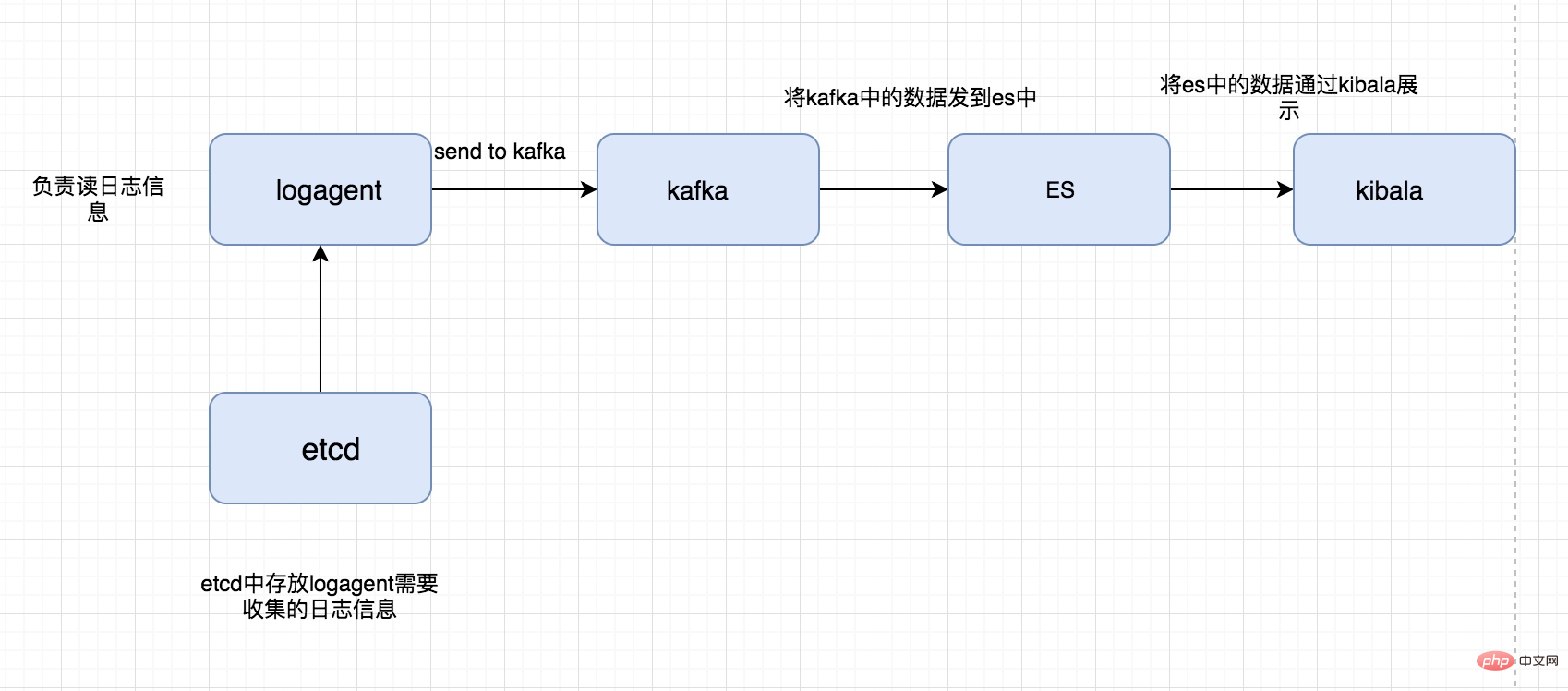Go 언어로 구현된 로그 수집 시스템에 대한 자세한 그래픽 및 텍스트 설명
- 尚앞으로
- 2019-11-27 15:47:354195검색

이 로그 수집 시스템의 프레임워크를 아래와 같이 정리했습니다
 이번에 구현할 코드의 전체적인 로직은 다음과 같습니다.
이번에 구현할 코드의 전체적인 로직은 다음과 같습니다.
 전체 코드 주소는 https://github입니다. com/pythonsite/logagent
전체 코드 주소는 https://github입니다. com/pythonsite/logagent
etcd 소개
구성 공유 및 서비스 검색에 사용할 수 있는 고가용성 분산 키-값 저장소
유사 프로젝트: Zookeeper 및 consul
개발 언어: go
인터페이스 : 사용하기 쉬운 편안한 인터페이스 제공
구현 알고리즘: raft 알고리즘 기반의 강력한 일관성, 고가용성 서비스 저장 디렉터리
etcd 응용 시나리오:
1. 서비스 검색 및 서비스 등록
2. 클라이언트가 사용해야 함)
3. 분산 잠금
4. 마스터 선거
공식 웹사이트에는 etcd에 대한 매우 간결한 소개가 있습니다:

etcd 구성:
다운로드 주소: https://github. com/coreos/etcd/releases/
자신의 환경에 맞게 해당 버전을 다운받아 실행하시면 됩니다
시작 후 다음 명령어로 확인 가능합니다:
[root@localhost etcd-v3.2.18-linux-amd64]# ./etcdctl set name zhaofan zhaofan [root@localhost etcd-v3.2.18-linux-amd64]# ./etcdctl get name zhaofan [root@localhost etcd-v3.2.18-linux-amd64]#
context 소개 및 사용
사실 이게 컨텍스트 관리인데 컨텍스트의 역할은 주로 다음 두 가지 기능을 가지고 있습니다.
1. 고루틴의 타임아웃 제어
2. 컨텍스트 데이터 저장
다음의 간단한 예를 통해 이해해 보세요. :
package main
import (
"fmt"
"time"
"net/http"
"context"
"io/ioutil"
)
type Result struct{
r *http.Response
err error
}
func process(){
ctx,cancel := context.WithTimeout(context.Background(),2*time.Second)
defer cancel()
tr := &http.Transport{}
client := &http.Client{Transport:tr}
c := make(chan Result,1)
req,err := http.NewRequest("GET","http://www.google.com",nil)
if err != nil{
fmt.Println("http request failed,err:",err)
return
}
// 如果请求成功了会将数据存入到管道中
go func(){
resp,err := client.Do(req)
pack := Result{resp,err}
c <- pack
}()
select{
case <- ctx.Done():
tr.CancelRequest(req)
fmt.Println("timeout!")
case res := <-c:
defer res.r.Body.Close()
out,_:= ioutil.ReadAll(res.r.Body)
fmt.Printf("server response:%s",out)
}
return
}
func main() {
process()
}context를 통해 context를 저장하는 context를 작성합니다. 코드 예시는 다음과 같습니다.
package main
import (
"github.com/Go-zh/net/context"
"fmt"
)
func add(ctx context.Context,a,b int) int {
traceId := ctx.Value("trace_id").(string)
fmt.Printf("trace_id:%v\n",traceId)
return a+b
}
func calc(ctx context.Context,a, b int) int{
traceId := ctx.Value("trace_id").(string)
fmt.Printf("trace_id:%v\n",traceId)
//再将ctx传入到add中
return add(ctx,a,b)
}
func main() {
//将ctx传递到calc中
ctx := context.WithValue(context.Background(),"trace_id","123456")
calc(ctx,20,30)
}etcd와 context를 함께 사용합니다
go를 통해 etcd를 연결하는 간단한 예시가 있습니다. 여기서 주목해야 할 작은 문제는 기본적으로 시작되는 etcd의 시작 방법입니다. 특히 가상으로 설치하는 경우 연결이 되지 않을 수 있으므로 다음 명령으로 시작해야 합니다.
./etcd --listen-client-urls http://0.0.0.0:2371 --advertise-client-urls http: //0.0.0.0:2371 --listen-peer-urls http://0.0.0.0: 2381
)
package main
import (
etcd_client "github.com/coreos/etcd/clientv3"
"time"
"fmt"
)
func main() {
cli, err := etcd_client.New(etcd_client.Config{
Endpoints:[]string{"192.168.0.118:2371"},
DialTimeout:5*time.Second,
})
if err != nil{
fmt.Println("connect failed,err:",err)
return
}
fmt.Println("connect success")
defer cli.Close()
}다음 예제는 etcd
package main
import (
"github.com/coreos/etcd/clientv3"
"time"
"fmt"
"context"
)
func main() {
cli,err := clientv3.New(clientv3.Config{
Endpoints:[]string{"192.168.0.118:2371"},
DialTimeout:5*time.Second,
})
if err != nil{
fmt.Println("connect failed,err:",err)
return
}
fmt.Println("connect succ")
defer cli.Close()
ctx,cancel := context.WithTimeout(context.Background(),time.Second)
_,err = cli.Put(ctx,"logagent/conf/","sample_value")
cancel()
if err != nil{
fmt.Println("put failed,err",err)
return
}
ctx, cancel = context.WithTimeout(context.Background(),time.Second)
resp,err := cli.Get(ctx,"logagent/conf/")
cancel()
if err != nil{
fmt.Println("get failed,err:",err)
return
}
for _,ev := range resp.Kvs{
fmt.Printf("%s:%s\n",ev.Key,ev.Value)
}
}에 연결하여 값을 저장하고 가져오는 것입니다package main
import (
"context"
"fmt"
)
func main() {
// gen generates integers in a separate goroutine and
// sends them to the returned channel.
// The callers of gen need to cancel the context once
// they are done consuming generated integers not to leak
// the internal goroutine started by gen.
gen := func(ctx context.Context) <-chan int {
dst := make(chan int)
n := 1
go func() {
for {
select {
case <-ctx.Done():
return // returning not to leak the goroutine
case dst <- n:
n++
}
}
}()
return dst
}
ctx, cancel := context.WithCancel(context.Background())
defer cancel() // cancel when we are finished consuming integers
for n := range gen(ctx) {
fmt.Println(n)
if n == 5 {
break
}
}
}컨텍스트 공식 웹사이트에도 예제가 있습니다. 매우 유용하며 열린 고루틴의 종료를 제어하는 데 사용됩니다. 코드는 다음과 같습니다. : package main
import (
"context"
"fmt"
"time"
)
func main() {
d := time.Now().Add(50 * time.Millisecond)
ctx, cancel := context.WithDeadline(context.Background(), d)
// Even though ctx will be expired, it is good practice to call its
// cancelation function in any case. Failure to do so may keep the
// context and its parent alive longer than necessary.
defer cancel()
select {
case <-time.After(1 * time.Second):
fmt.Println("overslept")
case <-ctx.Done():
fmt.Println(ctx.Err())
}
} 공식 홈페이지 문서에 있는 WithDeadline 데모의 코드 예시에 대해 : package main
import (
"github.com/coreos/etcd/clientv3"
"time"
"fmt"
"context"
)
func main() {
cli,err := clientv3.New(clientv3.Config{
Endpoints:[]string{"192.168.0.118:2371"},
DialTimeout:5*time.Second,
})
if err != nil {
fmt.Println("connect failed,err:",err)
return
}
defer cli.Close()
// 这里会阻塞
rch := cli.Watch(context.Background(),"logagent/conf/")
for wresp := range rch{
for _,ev := range wresp.Events{
fmt.Printf("%s %q : %q\n", ev.Type, ev.Kv.Key, ev.Kv.Value)
}
}
}위 코드를 보면 기본적인 사용법은 있고, etcd를 통해 하면 구성 관리, 구성이 변경되면 어떻게 알릴까요? 다음 예에서 볼 수 있듯이 구성 변경에 해당하는 서버: package main
import (
"github.com/Shopify/sarama"
"strings"
"fmt"
"time"
)
func main() {
consumer,err := sarama.NewConsumer(strings.Split("192.168.0.118:9092",","),nil)
if err != nil{
fmt.Println("failed to start consumer:",err)
return
}
partitionList,err := consumer.Partitions("nginx_log")
if err != nil {
fmt.Println("Failed to get the list of partitions:",err)
return
}
fmt.Println(partitionList)
for partition := range partitionList{
pc,err := consumer.ConsumePartition("nginx_log",int32(partition),sarama.OffsetNewest)
if err != nil {
fmt.Printf("failed to start consumer for partition %d:%s\n",partition,err)
return
}
defer pc.AsyncClose()
go func(partitionConsumer sarama.PartitionConsumer){
for msg := range pc.Messages(){
fmt.Printf("partition:%d Offset:%d Key:%s Value:%s",msg.Partition,msg.Offset,string(msg.Key),string(msg.Value))
}
}(pc)
}
time.Sleep(time.Hour)
consumer.Close()
}kafka 소비자 코드 구현의 간단한 예: package main
import (
"github.com/Shopify/sarama"
"strings"
"fmt"
"sync"
)
var (
wg sync.WaitGroup
)
func main() {
consumer,err := sarama.NewConsumer(strings.Split("192.168.0.118:9092",","),nil)
if err != nil{
fmt.Println("failed to start consumer:",err)
return
}
partitionList,err := consumer.Partitions("nginx_log")
if err != nil {
fmt.Println("Failed to get the list of partitions:",err)
return
}
fmt.Println(partitionList)
for partition := range partitionList{
pc,err := consumer.ConsumePartition("nginx_log",int32(partition),sarama.OffsetNewest)
if err != nil {
fmt.Printf("failed to start consumer for partition %d:%s\n",partition,err)
return
}
defer pc.AsyncClose()
go func(partitionConsumer sarama.PartitionConsumer){
wg.Add(1)
for msg := range partitionConsumer.Messages(){
fmt.Printf("partition:%d Offset:%d Key:%s Value:%s",msg.Partition,msg.Offset,string(msg.Key),string(msg.Value))
}
wg.Done()
}(pc)
}
//time.Sleep(time.Hour)
wg.Wait()
consumer.Close()
}그러나 위 코드는 최상의 코드가 아닙니다. 왜냐하면 우리는 마침내 고루틴의 실행을 기다리기 때문입니다. time.sleep을 통해 sync.WaitGroup을 사용하도록 변경할 수 있습니다. package main
import (
"github.com/coreos/etcd/clientv3"
"time"
"github.com/astaxie/beego/logs"
"context"
"fmt"
)
var Client *clientv3.Client
var logConfChan chan string
// 初始化etcd
func initEtcd(addr []string,keyfmt string,timeout time.Duration)(err error){
var keys []string
for _,ip := range ipArrays{
//keyfmt = /logagent/%s/log_config
keys = append(keys,fmt.Sprintf(keyfmt,ip))
}
logConfChan = make(chan string,10)
logs.Debug("etcd watch key:%v timeout:%v", keys, timeout)
Client,err = clientv3.New(clientv3.Config{
Endpoints:addr,
DialTimeout: timeout,
})
if err != nil{
logs.Error("connect failed,err:%v",err)
return
}
logs.Debug("init etcd success")
waitGroup.Add(1)
for _, key := range keys{
ctx,cancel := context.WithTimeout(context.Background(),2*time.Second)
// 从etcd中获取要收集日志的信息
resp,err := Client.Get(ctx,key)
cancel()
if err != nil {
logs.Warn("get key %s failed,err:%v",key,err)
continue
}
for _, ev := range resp.Kvs{
logs.Debug("%q : %q\n", ev.Key, ev.Value)
logConfChan <- string(ev.Value)
}
}
go WatchEtcd(keys)
return
}
func WatchEtcd(keys []string){
// 这里用于检测当需要收集的日志信息更改时及时更新
var watchChans []clientv3.WatchChan
for _,key := range keys{
rch := Client.Watch(context.Background(),key)
watchChans = append(watchChans,rch)
}
for {
for _,watchC := range watchChans{
select{
case wresp := <-watchC:
for _,ev:= range wresp.Events{
logs.Debug("%s %q : %q\n", ev.Type, ev.Kv.Key, ev.Kv.Value)
logConfChan <- string(ev.Kv.Value)
}
default:
}
}
time.Sleep(time.Second)
}
waitGroup.Done()
}
func GetLogConf()chan string{
return logConfChan
}클라이언트가 수집해야 하는 로그 정보를 etcd
etcd 처리 코드는 package main
import (
"time"
"sync/atomic"
"github.com/astaxie/beego/logs"
)
type SecondLimit struct {
unixSecond int64
curCount int32
limit int32
}
func NewSecondLimit(limit int32) *SecondLimit {
secLimit := &SecondLimit{
unixSecond:time.Now().Unix(),
curCount:0,
limit:limit,
}
return secLimit
}
func (s *SecondLimit) Add(count int) {
sec := time.Now().Unix()
if sec == s.unixSecond {
atomic.AddInt32(&s.curCount,int32(count))
return
}
atomic.StoreInt64(&s.unixSecond,sec)
atomic.StoreInt32(&s.curCount, int32(count))
}
func (s *SecondLimit) Wait()bool {
for {
sec := time.Now().Unix()
if (sec == atomic.LoadInt64(&s.unixSecond)) && s.curCount == s.limit {
time.Sleep(time.Microsecond)
logs.Debug("limit is running,limit:%d s.curCount:%d",s.limit,s.curCount)
continue
}
if sec != atomic.LoadInt64(&s.unixSecond) {
atomic.StoreInt64(&s.unixSecond,sec)
atomic.StoreInt32(&s.curCount,0)
}
logs.Debug("limit is exited")
return false
}
}마찬가지로 속도 제한입니다. 결국 여기에 처리가 추가되므로 로그 수집 프로그램은 현재 비즈니스의 성능에 영향을 미칠 수 없으므로 속도를 제한하기 위해 Limit.go가 추가됩니다. rrreee추천: go 언어 튜토리얼
위 내용은 Go 언어로 구현된 로그 수집 시스템에 대한 자세한 그래픽 및 텍스트 설명의 상세 내용입니다. 자세한 내용은 PHP 중국어 웹사이트의 기타 관련 기사를 참조하세요!

